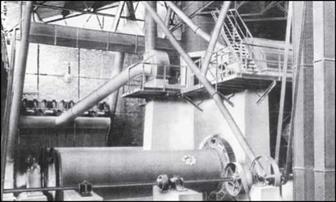After 1900 the grinding of Portland cement raw material and of cement clinker required large numbers of tumbling mills. This was also the heyday of gold mining. The old stamp mills that were used in great numbers for grinding gold ore did not grind sufficiently fine to liberate all of the gold, and the new tube mills were
|
|
installed following the stamps. After 1910 larger diameter tumbling mills with larger grinding media were developed. These could receive the finer crushed ore directly and the inefficient stamp batteries were gradually eliminated. …The first tumbling mills, or tube mills went into operation (on the Rand) in 1904. (SME — A1ME 1985)
By 1900, ball mills had been tested on the gold ores at Kalgoorlie, Australia, but the results were not always satisfactory.
Ball mills had for a long time a bad reputation. due to the fact that the excellent mills of this type built by Krupp had been imitated by local makers with unsatisfactory results; since this has been recognised they are again coming into use. (Schmeisser 1898)
A paper published by the Institution of Mining and Metallurgy in London gave a glimpse of how wet-grinding circuits worked on gold ores in 1904 (Rose 1906). The author reported that a circuit in the Hannan’s Star mill in Kalgoorlie consisted of a tube mill 1.2 m in diameter and 5 m long operating in closed circuit with a hydraulic classifier. The feed to the circuit was 38 tph of sands from a classifier, and the flow rate of the secondary hydraulic classifier sands back to the tube mill was 230 tph. The circuit feed and product sizings are given in Table 7.1. These data were representative of operating conditions at the time and show there was (1) efficient desliming by the hydraulic classifier, (2) a very fine classifier overflow stream that generated a large circulating load, and (3) overgrinding of the circuit product.
There was a clear need for better classification in wet-grinding circuits, a problem that was to be solved within the next few years.
The most spectacular changes that electricity brought to tumbling mills were the increases in mill and motor sizes (see Table 7.2) and in mill capacities. In 1900, few motors for tumbling mills were larger than 5 kW, but by 2000 electric motors were as large as 20,000 kW. In 1900, a few tons of ore could be ground per hour, but in 2000 a common production rate of a circuit containing a large mill was many hundred tons per hour.
Scale up of tumbling mills involves a number of factors as demonstrated by the scale. The power drawn by ball mills operating at the same (1) percent of volumetric
|
TABLE 7.1 Sizing distributions of the feed to and product from a tube mill-hydraulic classifier secondary grinding circuit in the Hannan’s Star mill, Kalgoorlie, in 1904
|
|
TABLE 7.2 Increases in dimensions and motor size of ball and autogenous/SAG tumbling mills in the 20th century |
|||||||
|
Ball Mills |
Autogenous/SAG Mills |
||||||
|
Year |
Diameter, m |
Length, m |
kW |
Year |
Diameter, m |
Length, m |
kW |
|
1909 |
1.2 |
2.1 |
11 |
1948 |
3.05 |
1.01 |
75 |
|
1912 |
1.9 |
2.3 |
41 |
1960 |
6.7 |
2.1 |
1,119 |
|
1927 |
2.4 |
2.4 |
168 |
1969 |
9.8 |
4.27 |
5,220 |
|
1940 |
3.05 |
2.8 |
447 |
1979 |
10.4 |
5.2 |
9,321 |
|
1963 |
3.9 |
5.5 |
1,491 |
1987 |
11 |
5.2 |
11,186 |
|
1970 |
5.6 |
6.4 |
3,169 |
1994 |
11 |
5.8 |
13,423 |
|
1990 |
6.1 |
9.3 |
5,593 |
1996 |
12 |
6.8 |
19,388 |
|
1997 |
7.3 |
10.5 |
10,440 |
1997 |
12.2 |
6.1 |
20,000 |
|
Source: Taggart 1927; SME- |
-AIME 1985; authors’ personal notes. |
loading, (2) percent of critical speed, and (3) length of grinding compartment varies as the ratio of the mill diameter is raised to the 2.3 power (D1/D2 )23. This applies when the power drawn by one mill diameter is known. This keeps the three key variables in the mill power equation at the same level with only mill diameter and power as variables. The mill volume varies as the diameter squared. As the mill diameter increases, the volume of the mill available per unit volume of the feed decreases. As ball mill diameter changes for a constant percent of critical speed, mill speed in revolutions per minute changes at inverse ratio of the square root of the mill diameter. The volume of the media in the mill is a function of the ratio of mill diameters squared. As the mill diameter increases the mill speed in revolutions per minute and the number of balls per unit of feed decrease, so the number of ore and media contacts decreases. As ball mills become larger in diameter, the largest mills become more inefficient—shown by either a decrease in feed rate to produce the specified grind or by a coarser grind at the designed feed rate. These scale-up factors result in the same manner in all tumbling mills. Mill power that is mill capacity is directly proportional to mill length.
Tumbling mills brought seminal change to fine grinding because they could grind pebbles to fine particles quickly and with much smaller use of energy than was previously possible. But they were not the panacea for all fine-grinding problems; for example, they are inefficient for breaking particles smaller than about 20-30 pm, because very small particles, like liquids, flow away from colliding balls. Changing the movement of the balls from tumbling to stirring reduced the problem of very fine grinding in ball mills. Stirred ball mills are discussed in Chapter 8.

